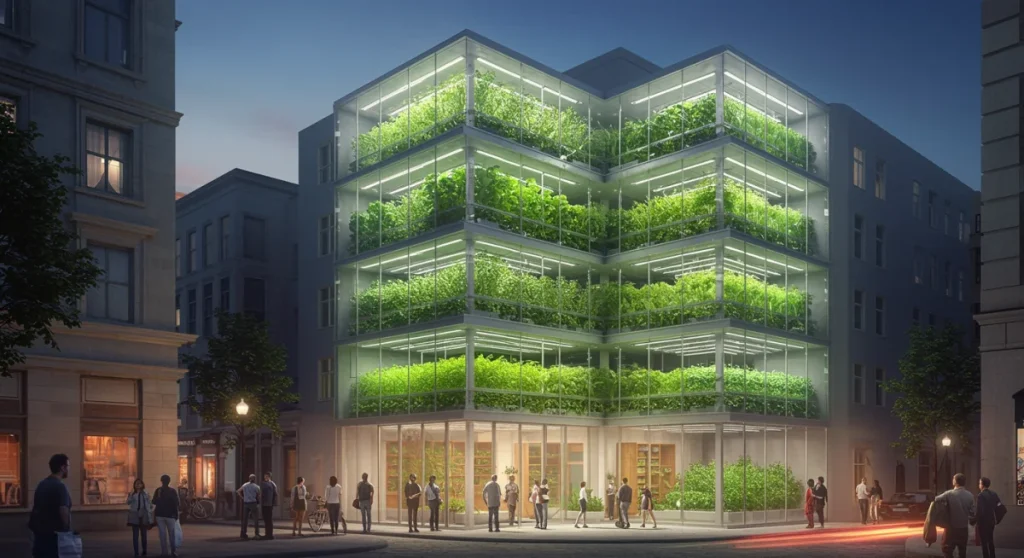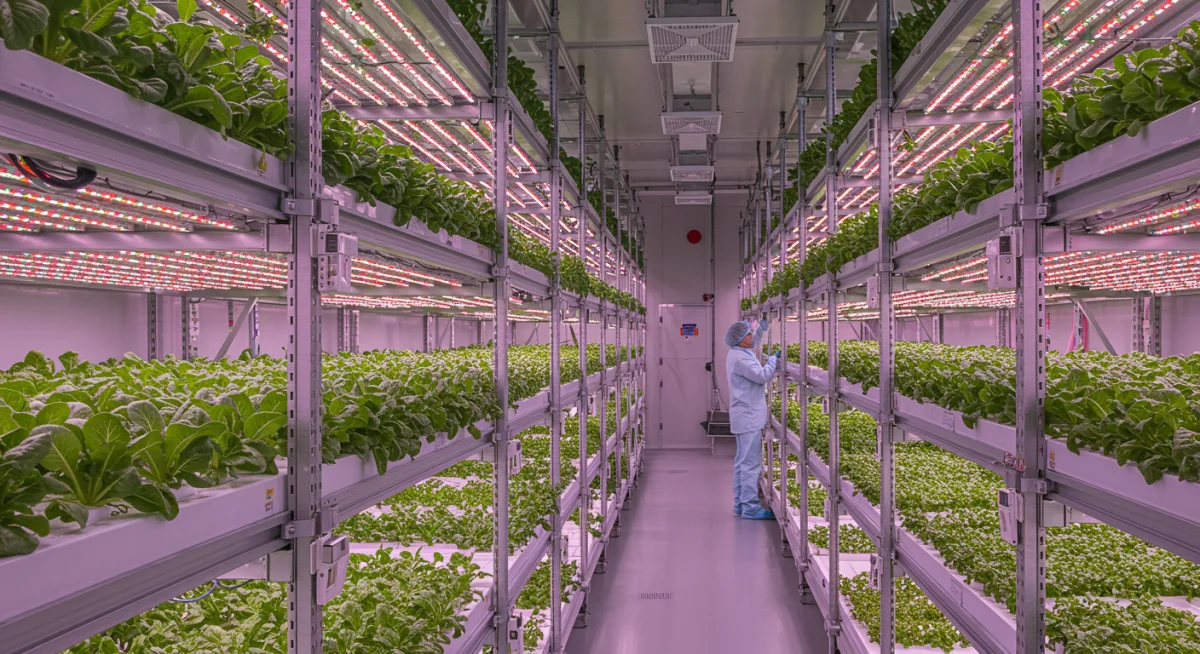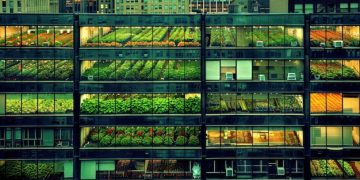Vertical Farms: Urban Fresh Produce & 30% Access by 2025

Urban vertical farming is poised to revolutionize food systems, offering city dwellers a projected 30% increase in fresh produce access by 2025 through innovative, localized cultivation methods.
Imagine biting into a crisp, fresh salad, knowing the greens were harvested just hours ago, mere blocks from your apartment. This isn’t a distant dream but a rapidly approaching reality, thanks to the accelerating trend of urban vertical farming. As cities expand and populations grow, the challenge of providing fresh, nutritious food becomes ever more pressing. Vertical farms offer an elegant solution, bringing agriculture directly into the heart of urban centers and promising a significant uplift in fresh produce accessibility for city dwellers by 2025.
The concept of vertical farming: growing up, not out
Vertical farming is an innovative agricultural method where food is grown in vertically stacked layers, often indoors. This approach utilizes controlled-environment agriculture (CEA) technology, which precisely manages temperature, humidity, light, and nutrients to optimize plant growth. Unlike traditional farming, which requires vast tracts of land, vertical farms can be established in urban warehouses, repurposed buildings, or even within residential structures, making them ideal for densely populated areas.
The core idea behind vertical farming is to maximize space efficiency and minimize environmental impact. By stacking crops, farmers can produce significantly more food per square foot compared to conventional methods. This not only addresses land scarcity in urban settings but also reduces the carbon footprint associated with long-distance transportation of produce.
Key technologies driving vertical farming
- LED lighting: Specialized LED lights mimic sunlight, providing optimal spectrums for different plant growth stages, consuming less energy than traditional grow lights.
- Hydroponics, aeroponics, and aquaponics: These soilless growing techniques deliver nutrients directly to plant roots, significantly reducing water usage and accelerating growth cycles.
- Environmental control systems: Sophisticated sensors and automation manage temperature, humidity, and CO2 levels, creating ideal microclimates for diverse crops.
- Data analytics and AI: These tools optimize growing conditions, predict yields, and detect potential issues, enhancing efficiency and productivity.
The integration of these technologies creates a highly efficient and sustainable food production system. It allows for year-round cultivation, impervious to external weather conditions or seasonal changes, ensuring a consistent supply of fresh produce. This reliability is a game-changer for urban food security, providing a stable source of nutrition regardless of climate fluctuations.
In essence, vertical farming represents a paradigm shift in how we think about food production. It moves agriculture from rural landscapes to urban interiors, transforming industrial spaces into verdant farms. This re-localization of food systems brings fresh produce closer to consumers, reducing waste and enhancing the nutritional value of what we eat.
Addressing urban food deserts and enhancing access
Urban food deserts, areas with limited access to affordable and nutritious food, are a significant challenge in many U.S. cities. Vertical farms offer a compelling solution by establishing food production directly within these underserved communities. This proximity drastically cuts down the ‘food mileage’—the distance food travels from farm to plate—ensuring that fresh, healthy options are readily available and more affordable.
The strategic placement of vertical farms in urban centers can bypass the complex and often expensive supply chains of traditional agriculture. This means that produce can be harvested and delivered to local markets, restaurants, and residents within hours, not days. The reduction in transportation costs and spoilage can translate into more competitive pricing for consumers, making nutritious food accessible to a wider demographic.
Impact on community health and local economies
Beyond mere availability, the presence of local vertical farms can foster healthier eating habits by providing a consistent supply of high-quality produce. When fresh vegetables and fruits are easily accessible and affordable, residents are more likely to incorporate them into their diets. This shift can lead to improved public health outcomes, including lower rates of diet-related illnesses.
Furthermore, vertical farms can stimulate local economies by creating new jobs in cultivation, technology management, and distribution. These jobs often require specialized skills, offering opportunities for training and employment within the community. The economic benefits extend to local businesses, which can source fresh ingredients directly from nearby vertical farms, enhancing the quality of their offerings and supporting a circular economy.
The ability of vertical farms to grow a diverse range of crops year-round also means that communities can enjoy a greater variety of fresh produce, regardless of the season. This diversification not only enriches diets but also strengthens food security by reducing reliance on a single source or type of crop. Ultimately, vertical farming is not just about growing food; it’s about cultivating healthier, more resilient urban communities.
Technological advancements driving efficiency and scale
The rapid evolution of technology is the engine behind the increasing viability and scalability of vertical farming. Innovations in artificial intelligence (AI), robotics, and data analytics are transforming every aspect of the growing process, from seed to harvest. These advancements are making vertical farms more efficient, productive, and ultimately, more profitable.
AI-driven systems can monitor plant health with unprecedented precision, detecting subtle changes in growth patterns or nutrient deficiencies before they become critical. This proactive approach minimizes crop loss and optimizes resource allocation. Robotics are increasingly being deployed for tasks such as planting, harvesting, and packaging, reducing labor costs and increasing operational speed. This automation frees up human workers to focus on more complex tasks, such as research and development or quality control.
Innovations in resource management
- Advanced water recirculation: Closed-loop hydroponic and aeroponic systems recirculate water, using up to 95% less water than traditional field farming.
- Precision nutrient delivery: AI systems customize nutrient solutions for specific crops, ensuring optimal growth while minimizing waste.
- Energy-efficient LED lighting: New generations of LEDs are increasingly efficient, reducing the significant energy footprint of indoor farming.
- Integrated pest management: Controlled environments naturally reduce pest issues, often eliminating the need for chemical pesticides, making produce healthier.
These technological leaps are not just about incremental improvements; they represent a fundamental shift in agricultural capabilities. They allow vertical farms to achieve higher yields, faster growth cycles, and superior product quality compared to conventional methods. The ability to precisely control every variable in the growing environment means that crops can be cultivated to exact specifications, meeting consumer demands for consistency and freshness.
As these technologies continue to mature and become more affordable, the economic case for vertical farming strengthens. This trend is attracting significant investment, further accelerating innovation and driving down operational costs. The scale and efficiency gained through technology are critical to meeting the ambitious goal of increasing urban fresh produce access by 30% by 2025.

Economic viability and investment landscape
The economic viability of vertical farming has been a topic of intense discussion, but recent advancements are significantly improving its financial outlook. While initial setup costs can be substantial due to the advanced technology involved, the long-term operational benefits are becoming increasingly attractive. These benefits include reduced land costs (especially in urban areas), lower water consumption, minimal pest and disease issues, and consistent year-round yields.
The investment landscape for vertical farming is booming, with venture capitalists and corporate giants pouring funds into innovative startups and established players. This influx of capital is fueling research and development, helping to refine technologies and optimize business models. Investors are drawn by the promise of sustainable food production, food security, and the potential for high returns in a rapidly expanding market.
Factors contributing to profitability
One key factor driving profitability is the ability to grow high-value crops that command premium prices in urban markets. Specialty greens, herbs, and certain fruits can be cultivated efficiently in vertical farms, offering a significant margin. The elimination of long-distance shipping also reduces costs and spoilage, ensuring a higher percentage of harvested produce reaches consumers in prime condition.
Furthermore, vertical farms can operate closer to their consumer base, reducing the need for extensive cold chain logistics and allowing for direct-to-consumer sales models. This direct connection can build stronger brand loyalty and provide valuable feedback for product development. Government incentives and subsidies for sustainable agriculture and urban development are also playing a crucial role in encouraging investment and growth in the sector.
The increasing demand for locally sourced, fresh, and pesticide-free produce is creating a robust market for vertical farm products. As consumer awareness about food origin and sustainability grows, so does the willingness to pay a premium for high-quality, ethically produced food. This consumer trend, coupled with technological advancements and strategic investments, is propelling vertical farming towards widespread economic success.
Challenges and sustainable solutions for growth
Despite its immense potential, vertical farming faces several challenges that require innovative and sustainable solutions for continued growth. High energy consumption, particularly for lighting and environmental control, remains a primary concern. The initial capital investment for building and equipping vertical farms can also be a barrier for new entrants. Furthermore, the specialized skill set required to operate these high-tech farms necessitates investment in training and education.
Addressing these challenges is critical for vertical farming to achieve its full potential and truly become a cornerstone of urban food systems. The industry is actively pursuing various strategies to mitigate these issues and ensure long-term sustainability. These efforts range from technological innovations to strategic partnerships and policy advocacy.
Overcoming key hurdles
- Energy efficiency: Continuous research into more efficient LED lighting, renewable energy integration (solar, wind), and advanced HVAC systems is reducing the energy footprint.
- Cost reduction: Automation, modular designs, and economies of scale are helping to lower both initial setup and operational costs over time.
- Crop diversity: Expanding beyond leafy greens to include a wider variety of fruits and vegetables will increase market appeal and profitability.
- Talent development: Educational programs and vocational training are being developed to create a skilled workforce capable of managing sophisticated farm operations.
Collaboration between vertical farming companies, research institutions, and government bodies is essential to overcome these challenges. By sharing knowledge, pooling resources, and advocating for supportive policies, the industry can accelerate the adoption of sustainable practices and drive down costs. Consumer education is also vital to highlight the benefits of vertically farmed produce, ensuring strong market demand.
Ultimately, the future of vertical farming hinges on its ability to evolve sustainably. By embracing energy-efficient technologies, optimizing resource use, and fostering a skilled workforce, vertical farms can move beyond niche markets and become a mainstream solution for feeding urban populations. This proactive approach will solidify its role in achieving greater food accessibility and security.
The future outlook: 30% more fresh produce by 2025
The projection of urban dwellers accessing 30% more fresh produce by 2025 due to vertical farming is an ambitious yet increasingly realistic goal. This significant increase will be driven by a confluence of factors, including continued technological innovation, growing consumer demand for local and sustainable food, and increased investment in urban agricultural infrastructure. The momentum building around vertical farming suggests a transformative period for urban food systems.
As vertical farms become more efficient and cost-effective, their presence in cities will expand rapidly. This expansion will not only involve the construction of new facilities but also the integration of vertical farming modules into existing urban landscapes, such as rooftops and unused industrial spaces. The decentralized nature of vertical farms means that fresh produce can be cultivated in numerous locations, creating a more robust and resilient food supply network.
Transformative impacts on urban living
The impact of this increased access extends beyond mere availability of food. It will foster healthier communities, reduce environmental footprints, and create vibrant local economies. Imagine cities where fresh, nutritious food is a given, not a luxury, and where the journey from farm to plate is measured in blocks, not thousands of miles. This vision is at the core of the vertical farming revolution.
Furthermore, the integration of vertical farms into urban planning can lead to more sustainable and livable cities. These farms can contribute to urban greening, improve air quality, and even help manage stormwater runoff. They represent a key component of a broader movement towards circular economies, where waste is minimized, and resources are efficiently utilized. The journey to 30% more fresh produce is not just about quantity; it’s about quality of life and the sustainability of our urban future.
The path to achieving 30% more fresh produce access by 2025 is clear, though it requires continued dedication and collaboration. By leveraging technology, fostering innovation, and building supportive communities, vertical farming is poised to redefine urban food systems, making fresh, healthy food a staple for every city dweller.
| Key Aspect | Brief Description |
|---|---|
| Increased Access | Urban dwellers are projected to access 30% more fresh produce by 2025. |
| Technological Drivers | AI, robotics, and LED lighting optimize growth, efficiency, and resource use. |
| Urban Integration | Vertical farms reduce food deserts and enhance local economies by growing food close to consumers. |
| Sustainability Focus | Efforts target reducing energy consumption and water use for long-term viability. |
Frequently Asked Questions about Vertical Farming
Vertical farming is an agricultural method where crops are grown in vertically stacked layers in a controlled indoor environment. It utilizes technologies like LED lighting, hydroponics, and environmental controls to optimize plant growth and maximize space efficiency, often in urban settings.
By locating farms directly within urban areas, vertical farming drastically reduces transportation distances and costs. This proximity ensures fresher produce reaches consumers faster, often at more competitive prices, especially in areas previously considered food deserts.
Vertical farms use significantly less water (up to 95% less than traditional farming) through recirculating systems. They also eliminate the need for pesticides and reduce carbon emissions associated with long-distance food transport, contributing to a smaller environmental footprint.
While initial setup costs can be high, ongoing technological advancements and increasing consumer demand for local, fresh produce are improving profitability. Reduced operational costs from efficiency, lower spoilage, and premium pricing for high-quality crops contribute to its growing economic viability.
Key challenges include high energy consumption for lighting and climate control, substantial initial capital investment, and the need for a specialized workforce. Addressing these through innovation and sustainable practices is crucial for widespread adoption and growth.
Conclusion
The trajectory of vertical farming indicates a profound shift in how urban populations will access fresh produce. The ambitious goal of a 30% increase in fresh food accessibility by 2025 is underpinned by relentless technological innovation, a burgeoning investment landscape, and a growing societal imperative for sustainable food systems. As these advanced farms become more integrated into our cities, they promise not only an abundance of nutritious food but also a pathway to more resilient, environmentally conscious, and healthier urban environments, fundamentally redefining our relationship with food production.





